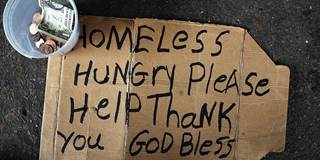The current election season in the US has reflected widespread concern about inequality. Reducing poverty, rather than penalizing earned success, is the right focus for dealing with it, and that means devising ways to boost participation in government programs to help the poor, while avoiding adverse effects on work incentives.
CAMBRIDGE – With a new American president and Congress taking office just six months from now, the time has come to rethink the government’s programs aimed at helping the poor. The current election season has reflected widespread concern about the issue of inequality. Reducing poverty, rather than penalizing earned success, is the right focus for dealing with it.
The United States government now spends more than $600 billion a year on programs to help the poor. That’s about 4% of America’s total GDP. Half of those outlays are for health programs, including Medicaid and the health-insurance subsidies under the 2010 Affordable Care Act (so-called Obamacare). The other half are for a complex range of programs including food stamps, housing subsidies, the Earned Income Tax Credit, and cash relief.
To put that 4% of GDP in perspective, the federal government’s total revenue from the personal income tax is less than 9% of GDP, implying that nearly half is spent on these means-tested programs. Spending on these programs also exceeds that for defense (3.3% of GDP) and the 3.3% of GDP spent on all other nondefense discretionary programs.

CAMBRIDGE – With a new American president and Congress taking office just six months from now, the time has come to rethink the government’s programs aimed at helping the poor. The current election season has reflected widespread concern about the issue of inequality. Reducing poverty, rather than penalizing earned success, is the right focus for dealing with it.
The United States government now spends more than $600 billion a year on programs to help the poor. That’s about 4% of America’s total GDP. Half of those outlays are for health programs, including Medicaid and the health-insurance subsidies under the 2010 Affordable Care Act (so-called Obamacare). The other half are for a complex range of programs including food stamps, housing subsidies, the Earned Income Tax Credit, and cash relief.
To put that 4% of GDP in perspective, the federal government’s total revenue from the personal income tax is less than 9% of GDP, implying that nearly half is spent on these means-tested programs. Spending on these programs also exceeds that for defense (3.3% of GDP) and the 3.3% of GDP spent on all other nondefense discretionary programs.